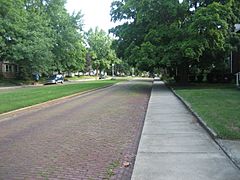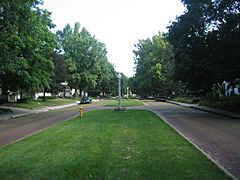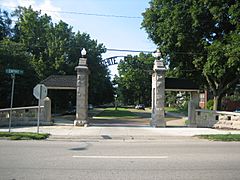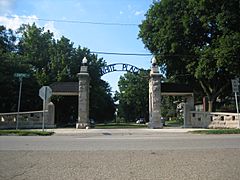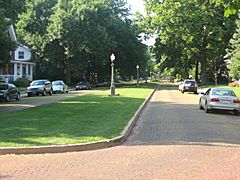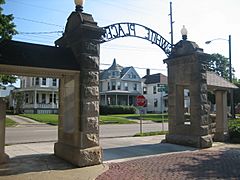White Place Historic District (Illinois) facts for kids
Quick facts for kids |
|
|
White Place Historic District
|
|
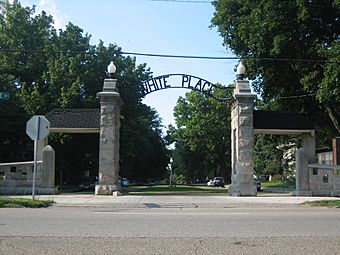
Gate at South end of White Place
|
|
| Location | White Pl., Clinton Blvd., and E side of Fell Ave. between Empire and Emerson Sts., Bloomington, Illinois |
|---|---|
| Area | 38.8 acres (15.7 ha) |
| Built | Various |
| Architect | Pillsbury, A.L.; Et al. |
| Architectural style | Late 19th And Early 20th Century American Movements, Late 19th And 20th Century Revivals, Late Victorian |
| NRHP reference No. | 88001230 |
| Added to NRHP | August 12, 1988 |
The White Place Historic District is a special neighborhood in Bloomington, Illinois. It's called a historic district because its buildings and area are important to history. This district includes many old houses. You can find these homes on White Place, North Clinton Boulevard, and Fell Avenue. The area is bordered by Empire Street to the south and Emerson Street to the north.
Most of these houses were built a long time ago, between 1895 and 1928. Many were built soon after S. R. White planned out the White Place area. The homes show off many different building styles. Some popular styles you'll see are Prairie School, American Craftsman, Colonial Revival, Victorian, and Spanish Colonial.
This historic district was added to the National Register of Historic Places on August 12, 1988. This means it's officially recognized as a place important to the history of the United States.
Contents
Exploring the White Place Historic District
The White Place Historic District is a great example of how neighborhoods grew in the early 1900s. It shows different styles of homes that were popular back then.
What is a Historic District?
A historic district is a group of buildings, structures, or sites that are important together. They might be important because of their history, how they were built, or what they look like. Protecting these areas helps us remember and learn about the past.
Architectural Styles You Can See
The houses in White Place show off several cool architectural styles. Each style has its own unique look and features.
Prairie School Style
The Prairie School style was popular in the Midwest. These homes often have flat roofs and wide, open layouts. They blend in with the flat landscape around them.
American Craftsman Homes
American Craftsman homes are known for their natural materials. You might see wood, stone, and brick. They often have wide porches and exposed beams.
Colonial Revival Style
Colonial Revival homes look back to the early American colonies. They often have grand entrances and symmetrical designs.
Victorian and Spanish Colonial Styles
You can also find Victorian homes with their fancy details and towers. Some homes even show the Spanish Colonial style, which brings in elements from Spanish architecture.
Images for kids
- White Place Historic District



